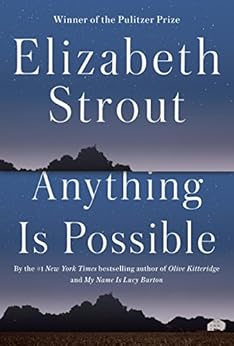I was
fortunate enough to receive an advance reading copy of My Name is Lucy Barton, a book I loved, so I was very excited to
receive an advance reading copy of Anything
is Possible, which is really a companion book. The second proved to be as good as the first.
Anything is Possible is a collection of linked stories
set in or near Amgash, Illinois, where Lucy Barton grew up. We are given the stories of the characters
that are mentioned in the conversations between Lucy and her mother. All characters are somehow connected to Lucy;
some are relatives while others have just a tangential connection.
Lucy’s
mentor told her that the job of “a writer of fiction was to report on the human
condition” and that is what Strout does.
One of Strout’s women thinks, “But this was life! And it was messy!” This messiness is what Stout shows: people struggling with the harsh realities of
life. All have sorrows, fears and
secrets. Many live in private
misery. More than one character suffers
from sexual dissatisfaction. Almost all
battle class prejudice. Abandonment,
loneliness, jealousy, guilt, unhappiness, and shame are some of the emotions which
dominate lives. Everyone seems damaged in some way because of
poverty or because of a lack of loving relationships - or both.
Despite their
damaged lives, people endure. Patty, one
of the characters, points out that despite Lucy’s shameful upbringing, “she had
risen right straight out of it.” People’s
lives can be redeemed; Dottie, another character, comes to understand “that
people had to decide, really, how they were going to live.” Abel, Lucy’s cousin who used to go dumpster
diving with her for food but who has become a successful and wealthy man, has
an epiphany at the end: “Anything was
possible for anyone.”
Another
major theme is that of family bonds.
Several of the characters come from dysfunctional families and they have
been scarred. Yet love remains
strong. Lucy does come to visit her brother
Pete and sister Vicky. Though Vicky is
resentful and jealous of Lucy’s success and feels abandoned by her sister who
never visits, she shows Lucy some compassion and even tells Pete, “’She’s not
coo-coo, Pete. She just couldn’t stand
being back here. It was too hard for
her.’” An elderly woman wants to tell
her daughter, “Listen to this! Lucy
Barton’s mother was awful to her, and her father – oh dear God, her father . .
. But Lucy loved them, she loved her
mother, and her mother loved her! We’re all just a mess . . . trying as hard as
we can, we love imperfectly . . . but
that’s okay.” This is exactly what Lucy’s
mentor said to her about her novel in My
Name is Lucy Barton: ““This is a
story about a mother who loves her daughter.
Imperfectly. Because we all love imperfectly.’”
The
characters in the book are diverse; some are good, decent people like Tommy
Guptill; some are forgiving and compassionate like Patty Nicely; some, like
Lila Lane, are judgmental and mean-spirited; others are difficult or troubled. What is amazing is that each emerges as a
multi-faceted character, both complex and complicated. Even characters who are not admirable or even
likeable are shown to be vulnerable.
Linda is a despicable person who married a predator but we are told that
she married him “who with his intelligence and vast money seemed to offer a
life that might catapult her away from the terrifying and abiding image of her
mother alone and ostracized.” Shelly
Small may be an insufferable snob but it is obvious that she was humiliated and
hurt by the comments of someone she had considered a friend.
The prose
is concise and lucid; there is not one superfluous word. Such writing inspires me to go back and
re-read My Name is Lucy Barton and
then to re-read Anything is Possible
too. Each is a standalone but they also
illuminate each other.
Note: I received an eARC of this book from the publisher via NetGalley.
Note: I received an eARC of this book from the publisher via NetGalley.

No comments:
Post a Comment